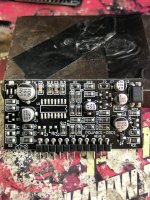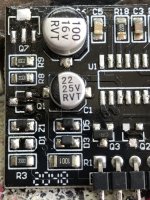Two sites show it as a CMDZ18L.
https://www.s-manuals.com/pdf/datasheet/c/m/cmdz1l8-cmdz47l_central.pdf
https://www.s-manuals.com/pdf/datasheet/c/m/cmdz1l8-cmdz47l_central.pdf
Thanks Sir Babin, also Q7 which is ZL (smd) it’s PNP 2SB1260, base on the circuit and nature of the component what regular transistor can I used as I have no access to that particular part now even if it’s thru hole I’ll mount it.Two sites show it as a CMDZ18L.
https://www.s-manuals.com/pdf/datasheet/c/m/cmdz1l8-cmdz47l_central.pdf
I don't know what you have. Something like a BD140 would work. The pin configuration is reversed. If you use something like that, fold it over the top of the board and use some sort of adhesive on the back of the board. The combination of those will help protect the pads from stress of the larger transistor.
I’m also having an issue with diode D1, which marked “W2”, the legend shows not a zener marking. What could be the likely part to used?

The decimal/dot in front of the marking may be important.
It looks like it was never installed on your board. Your board and the one you used above appear to be different.
It looks like it was never installed on your board. Your board and the one you used above appear to be different.
It was installed, I was the one who removed it as it was burnt and the zener above shorted along with the transistors and the TL494, I have another board that’s not pin for pin compatible but that side of the circuit is identical.The decimal/dot in front of the marking may be important.
It looks like it was never installed on your board. Your board and the one you used above appear to be different.
In the photo, the solder applied to the two pads is essentially exact in quantity and uniform in shape. It also has no solder flux around it. This is different from all other solder connections I see on the other missing components. If I'm wrong, it won't be the first time.
well the one with the missing parts is i remove all of them, it is a fully populated board, the previous image, is of the other board with the same components, but its not compatible with the amp im working on, the pin for connection is not in the same order for mounting.
Also bear in mind that i always scrub my board when i remove parts and when reinstall them (sometimes 90octane, Alcohol 70-90% and blow them dry with the heat gun)
Also bear in mind that i always scrub my board when i remove parts and when reinstall them (sometimes 90octane, Alcohol 70-90% and blow them dry with the heat gun)
Acetone is far better than alcohol. It evaporates almost immediately and contains no water. There is no need to use any heat to dry the boards.
You know ive been wanted to make a post about cleaning solvents, as recently my employer is having it with the vapors and the air conditioning unit. What would be a more ODORLESS cleaning solution liquid that is hard on flux residue, corrosion and yet mild on silkscreen labels, part identifiers, plastic and doesnt damage surrounding items if splashed due to brushing?Acetone is far better than alcohol. It evaporates almost immediately and contains no water. There is no need to use any heat to dry the boards.
Unless you use a water soluble flux, you won't likely find an odorless solution.
Acetone isn't any worse than alcohol unless you use far too much.
Acetone will not harm silkscreen but can remove markings on some components if you really scrub them. This isn't really a problem because you rarely need to clean the top of a board with through-hole components (it won't remove the markings on SMD parts). The exception for through-hole parts is around the gate resistors of failed FETs but you generally replace those resistors so it doesn't matter if they lose some of their markings.
Acetone WILL damage plastic panels made of ABS and clear lenses. It will also damage the finish on PPI amps. You can't use it without thinking but it's what I chose to use (and I tried virtually everything) for 30 years.
Acetone isn't any worse than alcohol unless you use far too much.
Acetone will not harm silkscreen but can remove markings on some components if you really scrub them. This isn't really a problem because you rarely need to clean the top of a board with through-hole components (it won't remove the markings on SMD parts). The exception for through-hole parts is around the gate resistors of failed FETs but you generally replace those resistors so it doesn't matter if they lose some of their markings.
Acetone WILL damage plastic panels made of ABS and clear lenses. It will also damage the finish on PPI amps. You can't use it without thinking but it's what I chose to use (and I tried virtually everything) for 30 years.
The PS driverboard is beyond repair, or my scope of repair, the customer says one of his handyman connected it to ac power (115vac) more seems like it was hit by lightning, I'm not getting anywhere on identifying the parts and mainly the diodes and zener diodes based on the markings.
Which PWM chip could be used to just drive the fets (without protection circuit) that uses fewer supporting components yet stable enough for a fulltime run? can someone supply that partnumber with a miminal developement diagram let me put it together? (e.g. TL494, SG3525, TA4424 etc....
Which PWM chip could be used to just drive the fets (without protection circuit) that uses fewer supporting components yet stable enough for a fulltime run? can someone supply that partnumber with a miminal developement diagram let me put it together? (e.g. TL494, SG3525, TA4424 etc....
I think it would be easier to use this board. There are conditions (voltages) that the driver IC needs. Confirm that the IC is seeing those conditions and work from there.
- Home
- General Interest
- Car Audio
- AudioPipe APMN-4095 PS Driver card

